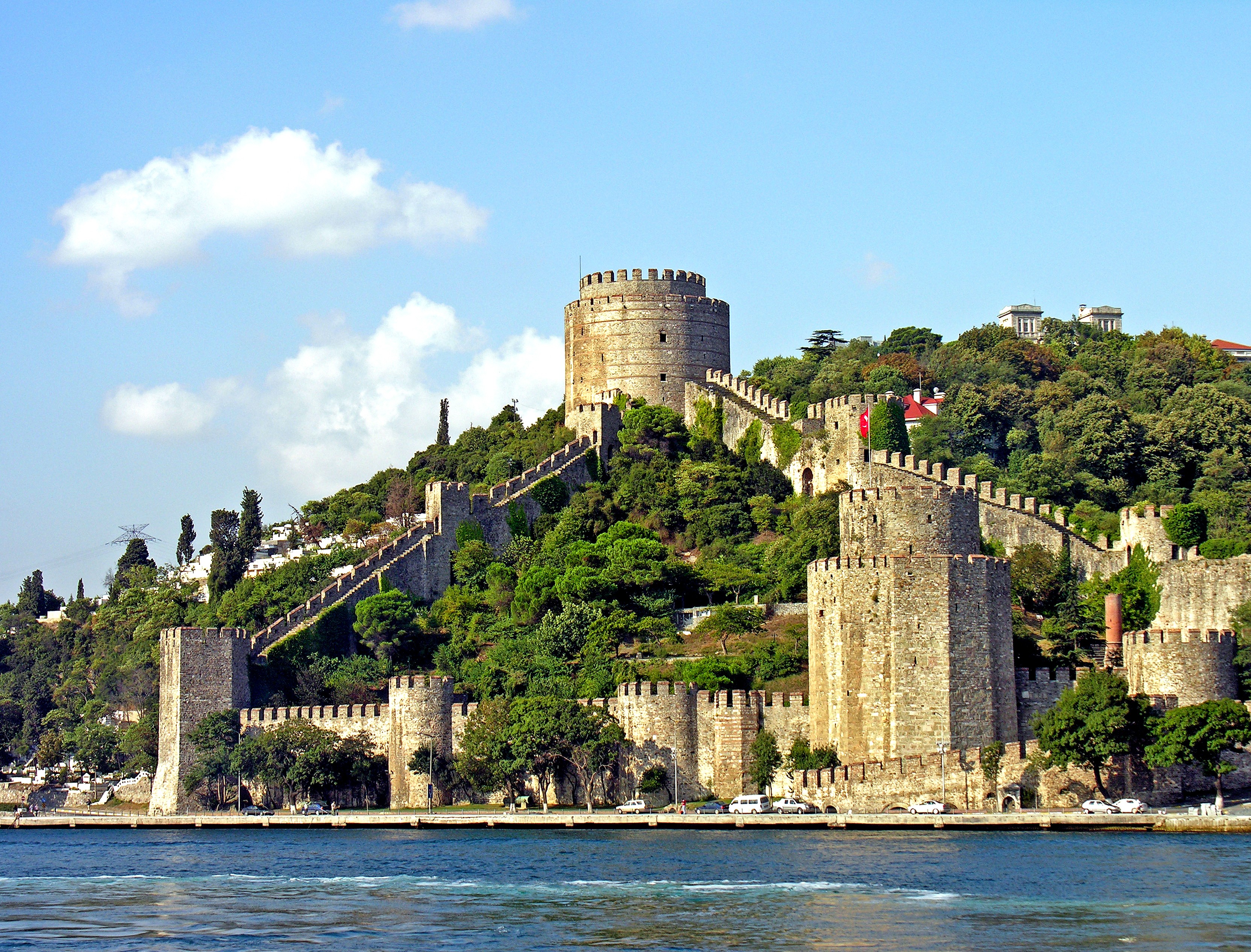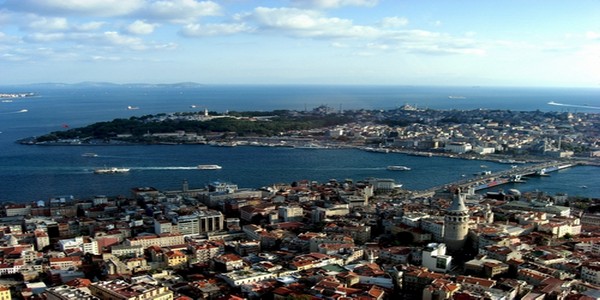The Battle of Singapore - 1942
When war broke out in the Far East, the Regiment was in process of expansion . . . In consequence . . . like many other units of our Imperial Forces, it was not fully prepared for the ordeal which it was to face. Nevertheless, these young and untried soldiers acquitted themselves in a way that bore comparison with the very best troops in Malaya. In particular, by their stubborn defence of the Pasir Panjang Ridge at the height of the Battle of Singapore, they set an example of steadfastness and endurance which will become a great tradition in the Regiment and an inspiration to future generations.
-Lieutenant General A.E. Percival-
The Malay Regiment
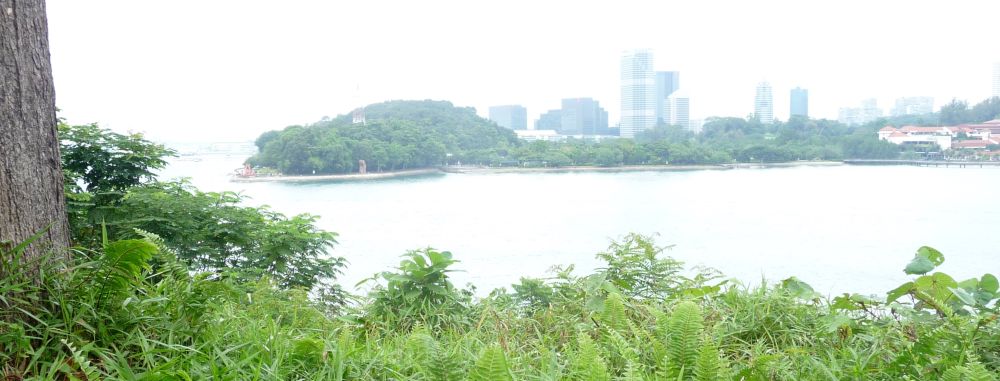
Above: Buena Vista Hill (left centre) from Blakang Mati (Sentosa) Island
The British colonial authorities in pre-World War II Malaya were very hesitant about starting a new infantry regiment of Malays because they doubted that the apparently easy-going Malay men could accept military discipline and be diligent in performing military duties. In the event the Malay Regiment totally confounded the colonial pessimists, particularly during the final few days before the British surrender of Singapore in mid-February 1942.
Discussions about starting the Malay Regiment began in 1920 between Malay Sultans and the British but it was not until 1st March 1933 that an experimental Company was raised, starting with 25 men selected from 1,000 applicants. Luckily for all concerned the officer placed in charge of the experiment was Major G.McI.S. Bruce MC of The Royal Lincolnshire Regiment, as he quickly learned to speak Malay and sympathetically familiarised himself with aspects of Malay culture and Islam.
Bruce quickly expanded the project and enlisted a further 125 men; there was never a shortage of applicants because they flocked to the Regiment’s barracks at Port Dickson. Training was based on a British Army syllabus with sports included, and was accompanied by an excellent diet and good recreational facilities. Nearly all words of command and instruction were given in the Malay language. Competitions were held for the smartest man on parade and for the best kit layout. British officers and Senior Ranks were seconded to the Regiment until Malays could be trained and promoted to replace them.
In 1934, after exhaustive tests, the authorities declared the experiment to be a success and agreed to the Company being expanded to Battalion strength and this was completed in 1936. The initial establishment figures were 17 British officers; 6 Malay officers; 11 British Warrant Officers and Senior Ranks and 759 other ranks. There were three rifle companies, ‘A’, ‘B’ and ‘C’, plus a support Company of medium machine gunners. More Malay officer cadets were recruited whenever suitable applicants came forward.
The Government of the Federated Malay States accepted financial responsibility for the maintenance of the Regiment. The colonial authorities were pleased as they now did not need to pay for a battalion of the Indian Army to be seconded for security duties in Malaya.
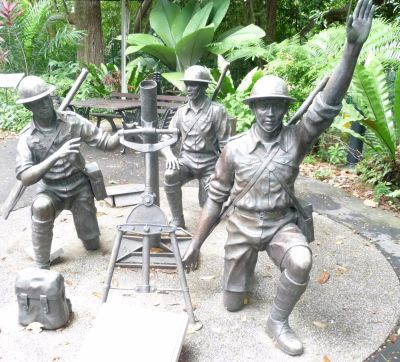
Sculpture of a Malay Regiment 3-inch MortarTeam
Bruce devised a Regimental mufti (non-uniform civilian clothes) that embodied national dress and which showed that the wearer was a soldier of the Regiment. The sarong and tie had three colours: green for Islam; yellow for Malay royalty; and red for the British Army connection. A religious teacher was appointed in 1933 and a large Regimental Mosque was built at Port Dickson. Morale within the Regiment was high and between 1933 and 1938 there was only one recorded case of desertion.
Infantry skills such as rifle, light machine gun and anti-tank rifle marksmanship, medium machine gunnery, 3-inch mortar procedures, signalling, pioneer, medical and provost duties were taught to a high standard and a regimental band and corps of drums were formed. Cooks, barbers and education staff were Malay. A Carrier Platoon comprising ten Bren gun carriers was formed and trained by the British Army 2nd Battalion The Loyal Regiment; the Loyals also assisted with the training of young Malay officers in Singapore.
When war broke out in Europe in 1939 additional Companies of the 1st Battalion were formed and later withdrawn to form a 2nd Battalion The Malay Regiment on 1st December 1941. The total strength of the 2nd Battalion was 453 men. One week later both Battalions were at war with Japan.
Infantry skills such as rifle, light machine gun and anti-tank rifle marksmanship, medium machine gunnery, 3-inch mortar procedures, signalling, pioneer, medical and provost duties were taught to a high standard and a regimental band and corps of drums were formed. Cooks, barbers and education staff were Malay. A Carrier Platoon comprising ten Bren gun carriers was formed and trained by the British Army 2nd Battalion The Loyal Regiment; the Loyals also assisted with the training of young Malay officers in Singapore.
When war broke out in Europe in 1939 additional Companies of the 1st Battalion were formed and later withdrawn to form a 2nd Battalion The Malay Regiment on 1st December 1941. The total strength of the 2nd Battalion was 453 men. One week later both Battalions were at war with Japan.
The fighting on the Malaya peninsula
When the Japanese invaded Malaya in early December 1941 the Commander of The Malay Regiment was Lieutenant Colonel J.T. Bretherton-Hawkshead-Talbot MC, who was based at the Port Dickson Depot. The 1st Battalion was commanded by Major J.R.G. Andre and the 2nd Battalion by Lieutenant Colonel F.W. Young. The only two sub-units to see action on the Malay Peninsula were ‘A’ and ‘D’ Companies of the newly raised and partially trained 2nd Battalion; each company consisted of three rifle platoons.
‘A’ Company experienced a reasonably straightforward withdrawal southwards from Kelantan on the east coast as part of 8th Indian Infantry Brigade, then as part of a Rearguard titled Macforce, and then as part of another grouping named Westforce. The company came under air attack a few times and was involved in skirmishes in Johore before it passed over the Singapore causeway in an exhausted condition on 24th January 1942 to join the 2nd Battalion at Normanton Camp. In Johore Corporal Napi had been killed and three other men wounded.
‘D’ Company commanded by Captain A.S. Taylor saw rather more action and exertion on the west coast. After serving as ordnance depot guards and convoy security escorts the men came under fire on the 18th December on the south bank of the Krian River near Sungai Bakap in Province Wellesley, repelling a Japanese attempt to cross the water using sampans (flat-bottomed local boats).
The Company was then withdrawn to Port Dickson, receiving enemy air attacks on the way, where it performed area security patrols looking for Japanese sea or airborne landings along the coast. By then the Japanese had air superiority, and because of a panicky British retreat from Penang Island during which many coastal craft were left intact, they had naval mobility which was used for outflanking operations.
As the series of Japanese tactical victories led to further British withdrawals down the west coast ‘D’ Company moved south to Batu Pahat, where on 18th January 1942 it was incorporated into 6/15th Infantry Brigade’s defence of the south bank of the Batu Pahat River. That night was quite lively as all three platoons repelled Japanese intruders. On the following night the Japanese outflanked the defenders who fell back to Senggarang airstrip. Fighting here amongst coconut plantations and mangrove swamps ‘D’ Company began to take casualties and lose men as prisoners of war. By this stage of the campaign the Japanese, although winning, were displaying streaks of cruelty when exasperated and groups of British wounded and unwounded soldiers were sometimes massacred.
When the Japanese invaded Malaya in early December 1941 the Commander of The Malay Regiment was Lieutenant Colonel J.T. Bretherton-Hawkshead-Talbot MC, who was based at the Port Dickson Depot. The 1st Battalion was commanded by Major J.R.G. Andre and the 2nd Battalion by Lieutenant Colonel F.W. Young. The only two sub-units to see action on the Malay Peninsula were ‘A’ and ‘D’ Companies of the newly raised and partially trained 2nd Battalion; each company consisted of three rifle platoons.
‘A’ Company experienced a reasonably straightforward withdrawal southwards from Kelantan on the east coast as part of 8th Indian Infantry Brigade, then as part of a Rearguard titled Macforce, and then as part of another grouping named Westforce. The company came under air attack a few times and was involved in skirmishes in Johore before it passed over the Singapore causeway in an exhausted condition on 24th January 1942 to join the 2nd Battalion at Normanton Camp. In Johore Corporal Napi had been killed and three other men wounded.
‘D’ Company commanded by Captain A.S. Taylor saw rather more action and exertion on the west coast. After serving as ordnance depot guards and convoy security escorts the men came under fire on the 18th December on the south bank of the Krian River near Sungai Bakap in Province Wellesley, repelling a Japanese attempt to cross the water using sampans (flat-bottomed local boats).
The Company was then withdrawn to Port Dickson, receiving enemy air attacks on the way, where it performed area security patrols looking for Japanese sea or airborne landings along the coast. By then the Japanese had air superiority, and because of a panicky British retreat from Penang Island during which many coastal craft were left intact, they had naval mobility which was used for outflanking operations.
As the series of Japanese tactical victories led to further British withdrawals down the west coast ‘D’ Company moved south to Batu Pahat, where on 18th January 1942 it was incorporated into 6/15th Infantry Brigade’s defence of the south bank of the Batu Pahat River. That night was quite lively as all three platoons repelled Japanese intruders. On the following night the Japanese outflanked the defenders who fell back to Senggarang airstrip. Fighting here amongst coconut plantations and mangrove swamps ‘D’ Company began to take casualties and lose men as prisoners of war. By this stage of the campaign the Japanese, although winning, were displaying streaks of cruelty when exasperated and groups of British wounded and unwounded soldiers were sometimes massacred.
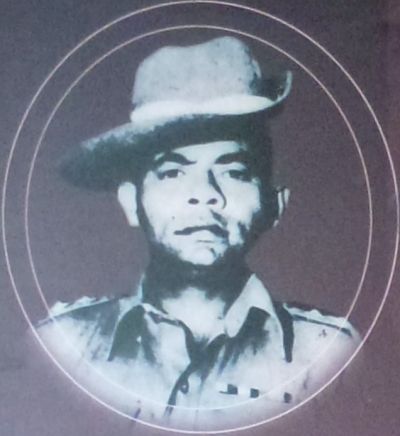
Lieutenant Ibrahim Bin Alla Ditta (Left) earned a Military Cross with the citation:
At a time when this officer’s company was cut off, in company with other British units, by the Japanese between Pahat and Senggarang in Johore, Lieutenant Ibrahim Bin Alla Ditta, on more than one occasion penetrated between the enemy’s positions and brought back extremely valuable information; he showed great bravery in carrying out this dangerous task.
On another occasion Lieutenant Ibrahim led his platoon forward to recover and haul back two British guns which had been hit but not severely damaged. The two other platoon commanders, Lieutenants Mohammed Ali and Yazid Ahmad also performed outstandingly, their local knowledge being used to good effect.
After Lieutenant Mohammed Ali accompanied the Brigade Major and a senior rank of 6/15th Brigade in a sampan 32 miles down the coast to request assistance from Divisional HQ at Pontian Kechil, the 2,000 remaining men of the Brigade were evacuated off a beach at Ponggor by HMS Dragonfly and HMS Scorpion on the 28th January. The Japanese were busily using a main road 1,000 yards away but the steadiness and discipline of the men awaiting embarkation ensured a quiet withdrawal. ‘D’ Company arrived on Singapore Island at 1400 hours on 29th January with men and weapons caked in mud from the evacuation beach. Both Battalions of The Malay Regiment were then on Singapore Island with the Depot staff and trainees divided between them; that increased the 2nd Battalion’s strength to 580 men.
On another occasion Lieutenant Ibrahim led his platoon forward to recover and haul back two British guns which had been hit but not severely damaged. The two other platoon commanders, Lieutenants Mohammed Ali and Yazid Ahmad also performed outstandingly, their local knowledge being used to good effect.
After Lieutenant Mohammed Ali accompanied the Brigade Major and a senior rank of 6/15th Brigade in a sampan 32 miles down the coast to request assistance from Divisional HQ at Pontian Kechil, the 2,000 remaining men of the Brigade were evacuated off a beach at Ponggor by HMS Dragonfly and HMS Scorpion on the 28th January. The Japanese were busily using a main road 1,000 yards away but the steadiness and discipline of the men awaiting embarkation ensured a quiet withdrawal. ‘D’ Company arrived on Singapore Island at 1400 hours on 29th January with men and weapons caked in mud from the evacuation beach. Both Battalions of The Malay Regiment were then on Singapore Island with the Depot staff and trainees divided between them; that increased the 2nd Battalion’s strength to 580 men.
Preparations for the Battle for Singapore Island
The two Battalions of the Malay Regiment had a combined strength of around 1,400 men including raw recruits, and they were placed with the 2nd Battalion The Loyal Regiment into the 1st Malaya Infantry Brigade. The Brigade, commanded by Brigadier G.G.R. Williams, late of the Loyals, was tasked with defending the western part of the Southern Area of Singapore Island. The 1st Battalion concentrated on beach defences in the sector west of Singapore City to the Jurong River; the 2nd Battalion occupied positions on the line of the Jurong River with forward troops west of the River. The Loyals were deployed on Belakang Mati Island (now named Sentosa Island) off the south coast of Singapore Island.
On the night of 8th February around 13,000 troops from two Japanese divisions crossed over from the mainland onto the north-west coast of Singapore Island. The Australian defence in that sector did not hold and soon demoralised Australian soldiers were retreating without orders. The Japanese were well outnumbered by the British but they fought harder and more ruthlessly and soon gained a moral superiority over some Indian Army battalions as well as Australian units. When a third Japanese division crossed over onto the island the men holding the British succession of defensive lines kept retreating as they were outflanked in turn.
By 11th February Brigadier Williams had concentrated his battalions with 1st Malay Regiment holding a line starting on the southern coast in Pasir Panjang village and running uphill 1,200 yards north to Hill 125; 2nd Malay Regiment extending this line further north but occupied positions west of Reformatory Road (which ran from Pasir Panjang village to Bukit Timah Village) to the junction with Ayer Rajah Road; then 2nd Loyals held positions north and south east of that road junction. The feature that the 1st Malay battalion was holding was known as Pasir Panjang Ridge, and the advancing Japanese troops intended to seize it. A section of Loyals Bren carriers moved to Pasir Panjang village where they assisted the 1st Malay in deterring Japanese patrols from advancing. The 1st Malay medium machine guns were sited on the high ground above the village and they also were used to break up advancing enemy groups. Night-time enemy “jitter” patrols using noisy firecracker grenades kept everyone in the Brigade awake, leading to exhaustion creeping in.
The two Battalions of the Malay Regiment had a combined strength of around 1,400 men including raw recruits, and they were placed with the 2nd Battalion The Loyal Regiment into the 1st Malaya Infantry Brigade. The Brigade, commanded by Brigadier G.G.R. Williams, late of the Loyals, was tasked with defending the western part of the Southern Area of Singapore Island. The 1st Battalion concentrated on beach defences in the sector west of Singapore City to the Jurong River; the 2nd Battalion occupied positions on the line of the Jurong River with forward troops west of the River. The Loyals were deployed on Belakang Mati Island (now named Sentosa Island) off the south coast of Singapore Island.
On the night of 8th February around 13,000 troops from two Japanese divisions crossed over from the mainland onto the north-west coast of Singapore Island. The Australian defence in that sector did not hold and soon demoralised Australian soldiers were retreating without orders. The Japanese were well outnumbered by the British but they fought harder and more ruthlessly and soon gained a moral superiority over some Indian Army battalions as well as Australian units. When a third Japanese division crossed over onto the island the men holding the British succession of defensive lines kept retreating as they were outflanked in turn.
By 11th February Brigadier Williams had concentrated his battalions with 1st Malay Regiment holding a line starting on the southern coast in Pasir Panjang village and running uphill 1,200 yards north to Hill 125; 2nd Malay Regiment extending this line further north but occupied positions west of Reformatory Road (which ran from Pasir Panjang village to Bukit Timah Village) to the junction with Ayer Rajah Road; then 2nd Loyals held positions north and south east of that road junction. The feature that the 1st Malay battalion was holding was known as Pasir Panjang Ridge, and the advancing Japanese troops intended to seize it. A section of Loyals Bren carriers moved to Pasir Panjang village where they assisted the 1st Malay in deterring Japanese patrols from advancing. The 1st Malay medium machine guns were sited on the high ground above the village and they also were used to break up advancing enemy groups. Night-time enemy “jitter” patrols using noisy firecracker grenades kept everyone in the Brigade awake, leading to exhaustion creeping in.
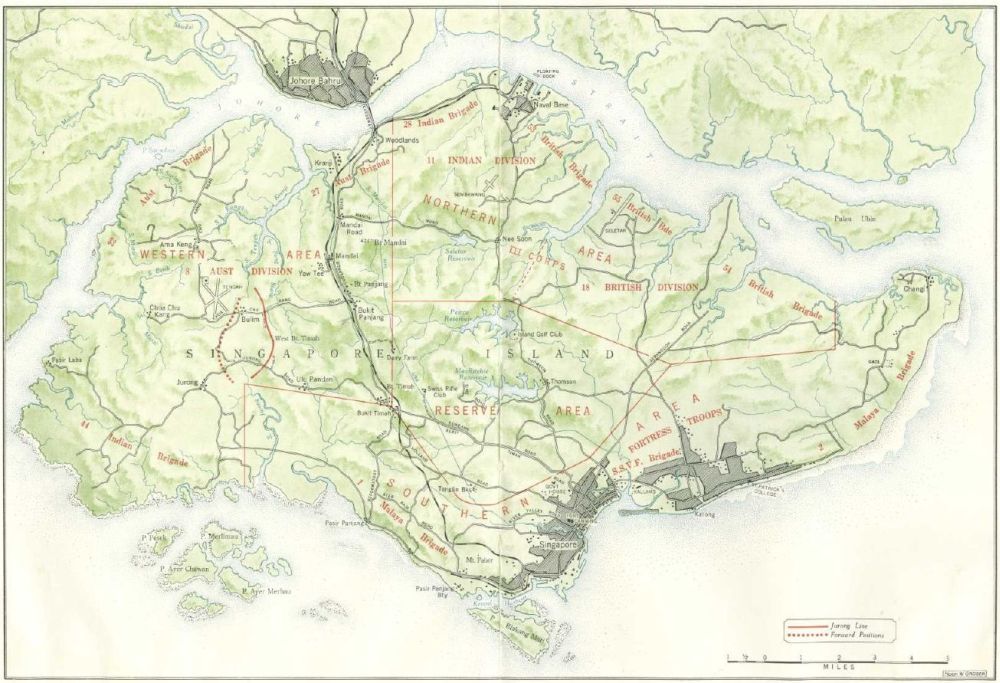
Above: British defence map of Singapore Island
The following day in the evening, seeing that his Brigade was exposed to the north because of withdrawals by other units, Brigadier Williams withdrew 2nd Malay and 2nd Loyals to the east of Reformatory Road. 2nd Malay was positioned in depth from Ayer Rajah Road south to The Gap Ridge. 1st Malay was left were it was in its good defensive positions. Deserters and demoralised stragglers from other units now passed from west to east through the Malay Battalions’ positions, but the discipline of the two Battalions stayed firm and positions were held without hesitation. Demolition fires had been started in the Normanton depot south-east of The Gap crossroads, and flames illuminated the night sky.
Not all British stragglers passed through the positions as some groups of men rallied and took up defensive posts in support of the Malays on Point 270 and along the ridge from there to The Gap. These unofficial reinforcements included 60 survivors of an anti-aircraft unit under a Captain Pool who manned Point 270 and the ridge to The Gap, and three Australian Bren gun carriers that supported the 1st Malay ‘B’ Company in Bueno Vista Village. Similarly the gunners from the Buena Vista Battery had disabled their guns as ordered and then joined 2nd Loyals as reinforcements. To the north the British defence of Singapore was crumbling, but on Pasir Panjang Ridge it stood waiting to be tested.
The fighting on Pasir Panjang Ridge
The 13th of February started ominously with heavy enemy bombardments of the 1st Malaya Brigade’s positions. Japanese observation officers were aloft in a tethered balloon to the west of the island and they adjusted their artillery fire very accurately (the Royal Air Force was by this time impotent or had evacuated itself); the HQs of both Malay Battalions received direct hits that killed key personnel and severely disrupted communications. At least five officers were killed by artillery and mortar fire and seven others were wounded before the Japanese moved forward.
In the early afternoon elements of the Japanese 18th Division advanced under supporting fire from mortars, artillery, aeroplanes and tanks. All the battalions in 1st Malaya Brigade were hit hard but the 2nd Malay received the hardest knocks. The enemy attack cut through 2nd Malay and its gunner reinforcements on Point 270 and seized Point 177. The undergrowth on the ridge was aflame and smoke filled the air. 2nd Malay fell back through the blazing Normanton fuel depot to the Alexandra Brickworks area. Regrettably a unit of Indian Sappers & Miners mistook the 2nd Malay soldiers for Japanese troops and fired at them and the Loyals who were west of the Malays. Some casualties occurred before order was restored and then 2nd Malay was withdrawn into Brigade Reserve on Bukit Chermin Hill.
The Japanese then turned on 1st Malay in Pasar Panjang Village and the slopes above it. Bren gun carriers from the Loyals and an unknown Australian unit supported the Malays, as did some British gunners fighting as infantrymen. Fires and smoke altered the battlefield to a series of independent actions where defenders had little knowledge of anything except the enemy manoeuvring to their front. Ammunition shortage and casualty evacuation were big problems for the young platoon commanders and the gunners acting as riflemen. Some positions were held until midnight when a withdrawal was made.
In this area No. 189 Private Yaakob Bin Bidin earned a Military Medal for taking the fight to the Japanese, as his citation shows:
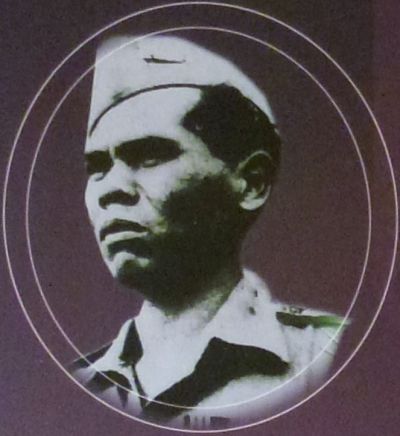
On 13th February 1942 No. 189 Private Yaakob Bin Bidin was in charge of a Bren Gun. The enemy attacked and outflanked his Company’s position, at the same time setting fire to the undergrowth in the vicinity. Regardless of personal safety this soldier advanced through the burning undergrowth until he was in a position from which he could open fire on an enemy mortar, which was causing casualties to his company. This enemy mortar he succeeded in completely neutralising.
When his platoon position was overrun by the Japanese Yaakob escaped death because he was unconscious from a wound, and the enemy attackers assumed that he was dead.
‘C’ Company 1st Malay, the defender of Pasir Panjang Village, was extracted at midnight by Bren gun carriers and moved back through ‘B’ Company 1st Malay which was holding a strong road block at Buena Vista Village. ‘C’ Company was then deployed 500 yards inland to a position at the end of Pasir Panjang Ridge near the Government Opium Factory. Throughout the day Major Andre and his 2nd in Command, Major G.T. Denaro, had visited the 1st Malay Companies to see the situation for themselves and to direct reorganization after a fight. These visits continued until hostilities ceased.
The Final hours of the Battle for Singapore
Saint Valentines’ Day, 14th February, saw ‘B’ Company 1st Malay under serious pressure at their roadblock in Buena Vista Village, and in the afternoon Japanese tanks broke through the block resulting in the defenders fighting hand to hand with the enemy infantry that followed the tanks. During the action the ‘B’ Company Commander, Major G.P. Richards, became trapped when his carrier was disabled by an enemy tank. Lieutenant A.G. McKenzie earned a Military Cross by rescuing him:
2nd Lieutenant (Acting Lieutenant) A.G. McKenzie, General List seconded Malay Regiment.
During the afternoon of 14th February 1942 Lieutenant McKenzie was at ‘B’ Company, 1st Battalion the Malay Regiment HQ. While there firing broke out from one of the forward platoons. The Company Commander went forward in a Bren Carrier to reconnoitre the situation. The carrier had gone about one hundred yards down the road when it encountered an enemy tank at 50 yards range. The carrier was twice hit and ditched.
Lieutenant McKenzie seeing this, and believing the Company Commander and driver to be wounded, went forward single handed to help them. He crept along the hedges and walls at the side of the road until he heard some shouting and looking over the hedge saw a party of Japanese bringing an Infantry gun into action supported by a tank. He engaged the gun team with his tommy gun killing or wounding the whole team. His action in doing so enabled the Company Commander and carrier driver to get away unharmed. Throughout the time that the Battalion was engaged with the enemy Lieutenant McKenzie showed the greatest coolness and courage.
Some ‘B’ Company men escaped east along the beach and joined men of 1st Malay on Labrador Hill; others were captured and a few continued fighting as they withdrew. 2nd Lieutenant Khalid Bin Hashim, supported by Sergeant Hussein Mat Som, got together 15 men of ‘B’ Company and defended a house, expecting a British counter-attack. They were shelled by their own side and after killing six Japanese stragglers for the loss of three of their own men (Privates Hamid Bin Man, Pilus Bin Aris, and Yassin Bin Hajji Latif) they withdrew to Labrador Hill.
Saint Valentines’ Day, 14th February, saw ‘B’ Company 1st Malay under serious pressure at their roadblock in Buena Vista Village, and in the afternoon Japanese tanks broke through the block resulting in the defenders fighting hand to hand with the enemy infantry that followed the tanks. During the action the ‘B’ Company Commander, Major G.P. Richards, became trapped when his carrier was disabled by an enemy tank. Lieutenant A.G. McKenzie earned a Military Cross by rescuing him:
2nd Lieutenant (Acting Lieutenant) A.G. McKenzie, General List seconded Malay Regiment.
During the afternoon of 14th February 1942 Lieutenant McKenzie was at ‘B’ Company, 1st Battalion the Malay Regiment HQ. While there firing broke out from one of the forward platoons. The Company Commander went forward in a Bren Carrier to reconnoitre the situation. The carrier had gone about one hundred yards down the road when it encountered an enemy tank at 50 yards range. The carrier was twice hit and ditched.
Lieutenant McKenzie seeing this, and believing the Company Commander and driver to be wounded, went forward single handed to help them. He crept along the hedges and walls at the side of the road until he heard some shouting and looking over the hedge saw a party of Japanese bringing an Infantry gun into action supported by a tank. He engaged the gun team with his tommy gun killing or wounding the whole team. His action in doing so enabled the Company Commander and carrier driver to get away unharmed. Throughout the time that the Battalion was engaged with the enemy Lieutenant McKenzie showed the greatest coolness and courage.
Some ‘B’ Company men escaped east along the beach and joined men of 1st Malay on Labrador Hill; others were captured and a few continued fighting as they withdrew. 2nd Lieutenant Khalid Bin Hashim, supported by Sergeant Hussein Mat Som, got together 15 men of ‘B’ Company and defended a house, expecting a British counter-attack. They were shelled by their own side and after killing six Japanese stragglers for the loss of three of their own men (Privates Hamid Bin Man, Pilus Bin Aris, and Yassin Bin Hajji Latif) they withdrew to Labrador Hill.
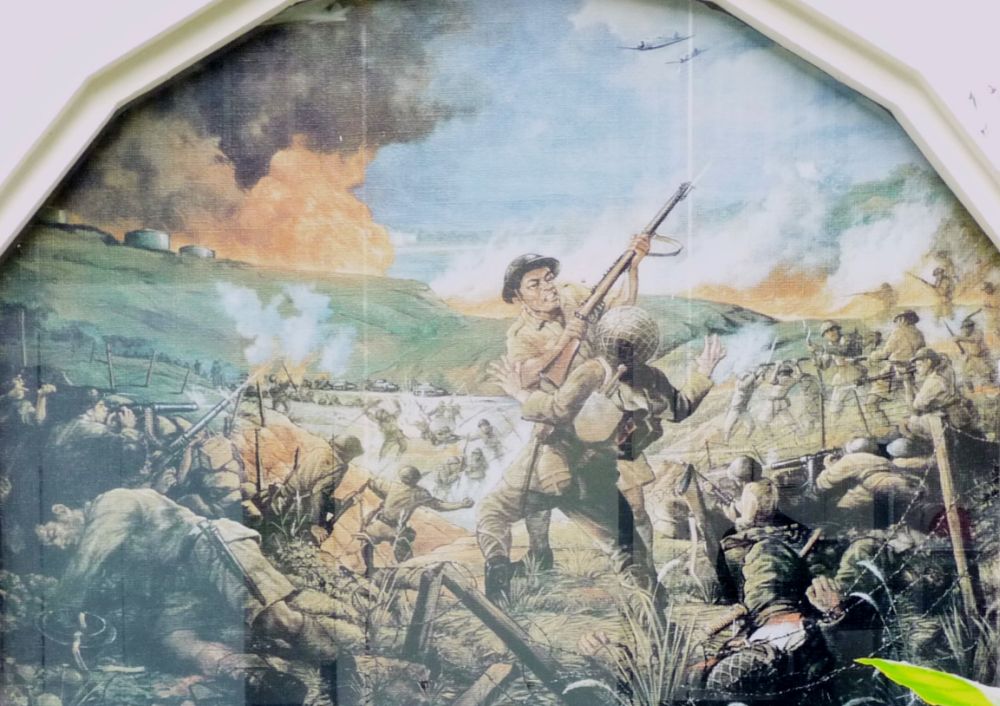
Above: Artist's impression of The Malay Regiment in action
‘C’ Company was located slightly inland on a hill near the Opium Factory but its isolated position was west of a big drain running from the Normanton oil depot, and the drain was full of burning oil that sometimes was an impassable wall of fire. After receiving enemy shell fire in the morning a column of soldiers dressed as Indian Army Punjabi troops advanced towards ‘C’ Company. But seeing that the ‘Punjabis’ were marching in four ranks instead of the British three ranks the Malays opened fire with Lewis guns and killed over 20 of them; this incensed the Japanese who had been masquerading as Punjabis. Two hours later a heavy enemy attack hit the Malays and penetrated the defence. The Malays stood their ground, fighting until they were over-run, all the officers except Lieutenant Adnan Bin Saidi and 2nd Lieutenant Abbas Bin Abdul Manan were killed. Lieutenant Adnan Bin Saidi was taken alive and bayoneted to death along with several of his men; his body was then hung by its feet from a tree and burial was denied. Lieutenant Adnan, commanding No. 7 Platoon, although wounded had handled a Lewis gun as the Japanese approached and he had exhorted his men to fight to the death, which many of them did. The Japanese had not anticipated such a level of aggression and sacrifice from fellow Asians.
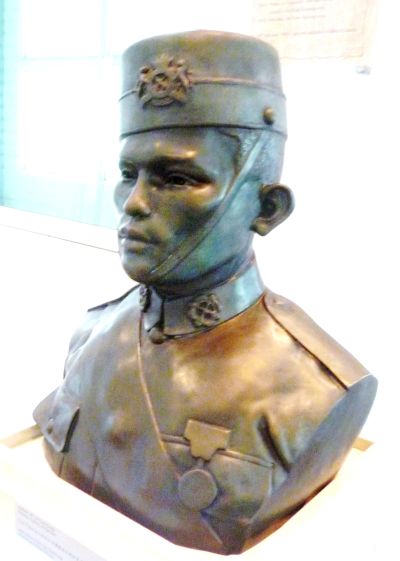

Sculpture of Lieutenant Adnan bin Saidi
2nd Lieutenant Abbas Bin Abdul Manan and four survivors from his platoon attempted to escape, two of the men being badly burned in the drain fire before the three others got back to Labrador Hill and reported the demise of ‘C’ Company. Both Lieutenant Adnan Bin Saidi and 2nd Lieutenant Abbas Bin Abdul Manan were later awarded a Mention in Despatches, Adnan’s being posthumous. The two burned men crawled away and hid themselves overnight before being found and recovered by ‘B’ Company men the following day.
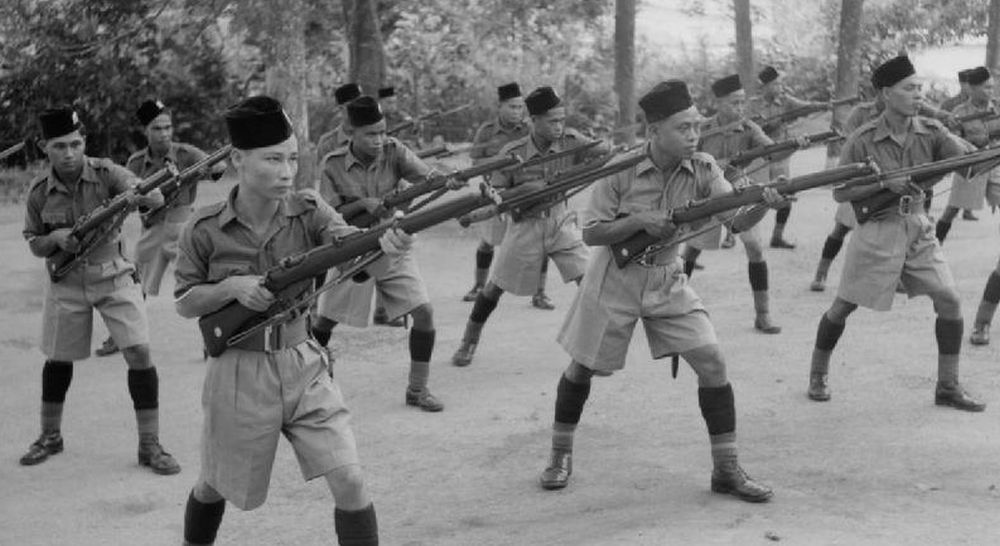
Above: The Malay Regiment at bayonet practice, Singapore
The last serious action between the Malay Regiment and the Japanese took place in the evening of the 14th February when a column of around two companies of Japanese openly marched towards ‘D’ Company 1st Malay. Why the Japanese moved like that is not known, nor why they did not use tanks – perhaps they had been given false information. ‘D’ Company and Bn HQ were strongly entrenched on a low hill overlooking the brickworks and the Battalion’s 3-inch mortars were in position. In the words of Lieutenant McKenzie:
“Imagine our surprise and delight when the Nips appeared marching straight down the Pasir Panjang Road – in fours! We let them get to within 100-150 yards of ‘D’ Company HQ and let them have it with machine guns first and then mortars. Almost every man of the first company was slaughtered and a lot further back too. A Loyals officer up on the right counted 94 bodies on that part of the road that he could see alone.”
A participant, Private Sulong Ahmed, later stated that every available weapon was used against the Japanese – rifles, Lewis guns, rifle grenades, revolvers, anti-tank rifles and mortars. Sulong was wounded seriously in the neck and sent to hospital. The surviving Japanese took cover and returned fire then withdrew after darkness fell. Regimental Sergeant Major (RSM) Ismail Bin Baba corroborated Sulong Ahmed’s account stating that the enemy bodies lay piled on top of each other.
RSM Ismail had been a tower of strength to Major Andre and later he was admitted as a Member of The Order of The British Empire (MBE) with this citation:
During the period 11th to 15th February 1942 when the Battalion were in close contact with the enemy No. 88 Regimental Sergeant Major Ismail Bin Baba carried out his duties with great devotion, loyalty and courage. His courage and coolness while under fire was the greatest value in steadying and encouraging the Malay other ranks. Even at the most critical moments he showed great coolness and loyalty and complete disregard for personal safety.
“Imagine our surprise and delight when the Nips appeared marching straight down the Pasir Panjang Road – in fours! We let them get to within 100-150 yards of ‘D’ Company HQ and let them have it with machine guns first and then mortars. Almost every man of the first company was slaughtered and a lot further back too. A Loyals officer up on the right counted 94 bodies on that part of the road that he could see alone.”
A participant, Private Sulong Ahmed, later stated that every available weapon was used against the Japanese – rifles, Lewis guns, rifle grenades, revolvers, anti-tank rifles and mortars. Sulong was wounded seriously in the neck and sent to hospital. The surviving Japanese took cover and returned fire then withdrew after darkness fell. Regimental Sergeant Major (RSM) Ismail Bin Baba corroborated Sulong Ahmed’s account stating that the enemy bodies lay piled on top of each other.
RSM Ismail had been a tower of strength to Major Andre and later he was admitted as a Member of The Order of The British Empire (MBE) with this citation:
During the period 11th to 15th February 1942 when the Battalion were in close contact with the enemy No. 88 Regimental Sergeant Major Ismail Bin Baba carried out his duties with great devotion, loyalty and courage. His courage and coolness while under fire was the greatest value in steadying and encouraging the Malay other ranks. Even at the most critical moments he showed great coolness and loyalty and complete disregard for personal safety.
Although the day finished on a high note for 1st Malay, elsewhere for the British it had been a bad day, especially for the patients and staff of Alexandra Hospital. After a group of Indian soldiers had fired on the enemy from within the hospital grounds Japanese troops stormed into the hospital and in an orgy of killing massacred over 200 patients and staff. A corporal of the Loyals was bayoneted to death whilst lying on the operating table.
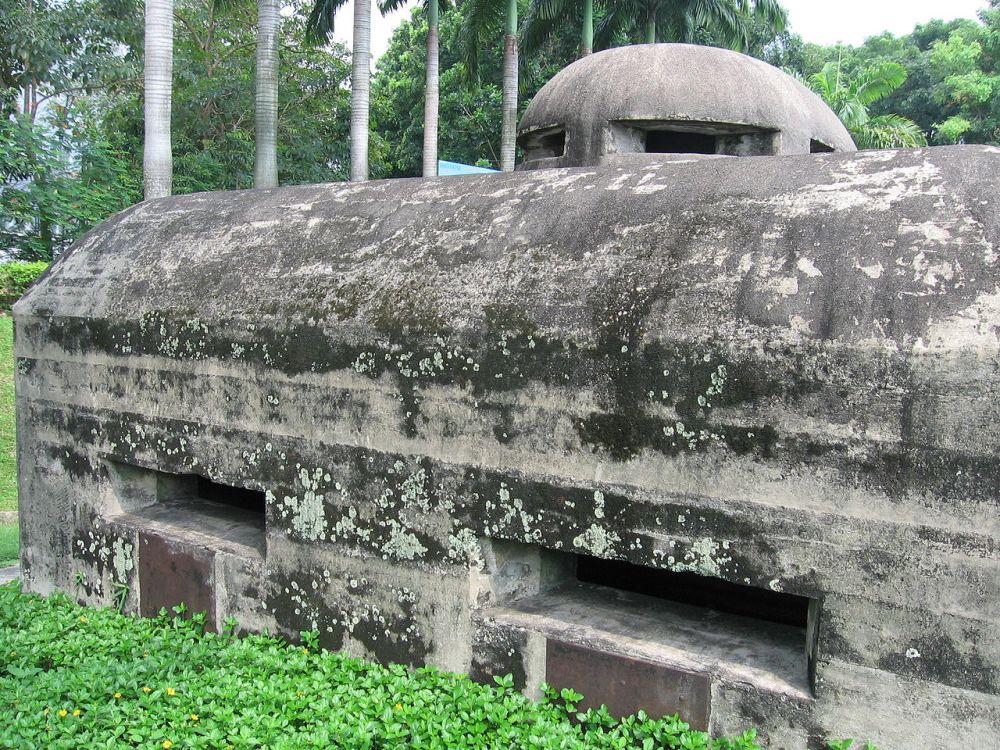
Pasir Panjang Village machine gun pillbox.
The surrender
On the final day of fighting, the 15th February, the Japanese confronting 1st Malay Brigade threw most of their weight against the Loyals who were now defending Gillman Barracks, their peace-time home. Both Malay Battalions had a relatively quiet day, re-organising and searching for battlefield casualties. By 2000 hours that evening all British units were being informed through their chain of command that they had surrendered to the Japanese invaders.
Major Andre then gave a very prescient order to the Malay officers in the 1st Battalion, telling them to put on non-regimental mufti and vanish into the civilian population; he saved their lives. On the 15th and 16th February the survivors of both Battalions gathered on the Keppel Golf Links area where the Japanese segregated the Malay personnel – eight officers and around 600 men – before marching them off to join the Indian troops in the Farrer Park concentration area. The British personnel were eventually marched to and interned in Changi Military Camp.
The Japanese were disappointed in the fact that Malays had fought against them instead of rising up to fight against the British, but generally after a short period of imprisonment or forced labour the Malay prisoners of war were released to return home. Some of the Malay prisoners were unlucky and were sent to labour camps in Thailand and Indonesia, and a few were amongst a group of nearly 100 Malay prisoners, probably mostly of Chinese extraction, who were massacred by machine gun fire near The Gap. The Japanese were ruthlessly determined to destroy any Chinese ability to fight back through resistance movements, and the easiest way to do that was to murder as many young Chinese men as was possible.
On the final day of fighting, the 15th February, the Japanese confronting 1st Malay Brigade threw most of their weight against the Loyals who were now defending Gillman Barracks, their peace-time home. Both Malay Battalions had a relatively quiet day, re-organising and searching for battlefield casualties. By 2000 hours that evening all British units were being informed through their chain of command that they had surrendered to the Japanese invaders.
Major Andre then gave a very prescient order to the Malay officers in the 1st Battalion, telling them to put on non-regimental mufti and vanish into the civilian population; he saved their lives. On the 15th and 16th February the survivors of both Battalions gathered on the Keppel Golf Links area where the Japanese segregated the Malay personnel – eight officers and around 600 men – before marching them off to join the Indian troops in the Farrer Park concentration area. The British personnel were eventually marched to and interned in Changi Military Camp.
The Japanese were disappointed in the fact that Malays had fought against them instead of rising up to fight against the British, but generally after a short period of imprisonment or forced labour the Malay prisoners of war were released to return home. Some of the Malay prisoners were unlucky and were sent to labour camps in Thailand and Indonesia, and a few were amongst a group of nearly 100 Malay prisoners, probably mostly of Chinese extraction, who were massacred by machine gun fire near The Gap. The Japanese were ruthlessly determined to destroy any Chinese ability to fight back through resistance movements, and the easiest way to do that was to murder as many young Chinese men as was possible.

| Above: The wooded slopes in the foreground and centre were the final positions of 1st Malaya Brigade |
Five Malay officers of 2nd Malay fell foul of their captors whilst prisoners of war, and they paid the ultimate price. The officers were Lieutenants: Mohd Ariffin Bin Haji Sulaiman; Abdul Wahid Bin Judin; Ibrahim Bin Sidek; Abdullah Bin Saat and Abbas Bin Mohd Saaid. These five honourable men, along with three Malay Volunteer Forces officers: Captain Raja Aman Shah; 2nd Lieutenant Abu Bakar and Lieutenant Osman Bin Kring, refused to either work for the Japanese or remove their British uniforms and badges of rank. All eight brave men were executed by the Japanese. Lieutenant Abbas Bin Mohd Saaid posthumously received a Mention in Despatches.
The award of two Distinguished Service Orders
Major J.R.G. Andre later was awarded Companionship of The Distinguished Service Order (DSO):
During the fighting at Singapore Island between the 11th and 15th February 1942, this officer commanded his Battalion with great gallantry combined with extreme calmness and judgement. The Battalion, which had not previously been under fire and which was largely officered by inexperienced personnel, took a prominent part in the successful defence of the western outskirts of Singapore. The casualties, both in officers and men were numerous, but throughout Major Andre maintained a high standard of efficiency and morale. It was due to his own personal courage and personality that the Battalion under his Command played its part well. He was invariably cheerful and cool in emergency, and at all times inspired those under him by his example.
His Battalion 2nd in Command, Major G.T. Denaro also received a DSO:
This officer served with great distinction during the fighting on Singapore Island between 11th and 15th February 1942. On one occasion, as 2nd in Command of the 1st Battalion he went along to the assistance of one company in which three officers had been killed and which had become disorganised. Under intense fire he rallied the remnants of the Company and part of another Company which had also received heavy casualties. By his personal courage and determination he restored the situation at a critical time. Although wounded on 14th February he remained at duty and continued to inspire all ranks by his cheerful and gallant conduct throughout the operations.
The award of two Distinguished Service Orders
Major J.R.G. Andre later was awarded Companionship of The Distinguished Service Order (DSO):
During the fighting at Singapore Island between the 11th and 15th February 1942, this officer commanded his Battalion with great gallantry combined with extreme calmness and judgement. The Battalion, which had not previously been under fire and which was largely officered by inexperienced personnel, took a prominent part in the successful defence of the western outskirts of Singapore. The casualties, both in officers and men were numerous, but throughout Major Andre maintained a high standard of efficiency and morale. It was due to his own personal courage and personality that the Battalion under his Command played its part well. He was invariably cheerful and cool in emergency, and at all times inspired those under him by his example.
His Battalion 2nd in Command, Major G.T. Denaro also received a DSO:
This officer served with great distinction during the fighting on Singapore Island between 11th and 15th February 1942. On one occasion, as 2nd in Command of the 1st Battalion he went along to the assistance of one company in which three officers had been killed and which had become disorganised. Under intense fire he rallied the remnants of the Company and part of another Company which had also received heavy casualties. By his personal courage and determination he restored the situation at a critical time. Although wounded on 14th February he remained at duty and continued to inspire all ranks by his cheerful and gallant conduct throughout the operations.
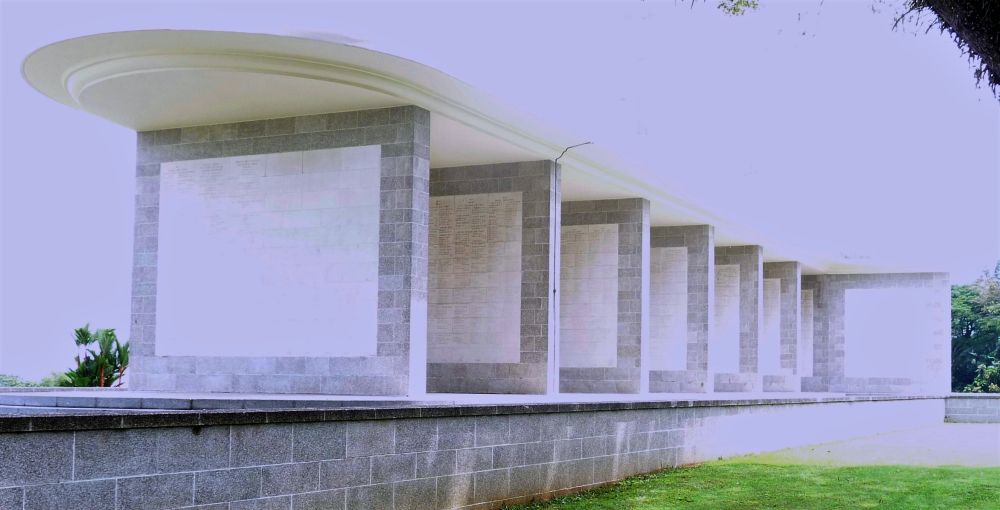
Above: A wing of the Singapore Memorial
A successful escape to India and the award of two Military Crosses
Two British officers escaped from Singapore and eventually reached India to continue serving in the British Forces. Their citation tells their tale:
Captain (acting Major) G.P. Richards, The South Staffordshire Regiment (attached The Malay Regiment).
2nd Lieutenant (acting Captain) E.H.S. Bretherton, General List (attached The Malay Regiment).
These two officers were captured at Singapore on 15th February 1942, and were imprisoned on the top floor of Gillman Barracks in very over-crowded conditions. Four days later, owing to the guard’s inattention, they managed to slip downstairs unobserved, and after hiding in an unused room until late at night they crept out of the barrack area. For three days they travelled over the island looking for food to supplement the scanty ration they had brought away with them. They discovered that two Japanese were quartered in every village, and that daily house to house searches were made, during which all iron implements and a good many clothes were taken and that in houses where there were women, trouble generally took place.
Two British officers escaped from Singapore and eventually reached India to continue serving in the British Forces. Their citation tells their tale:
Captain (acting Major) G.P. Richards, The South Staffordshire Regiment (attached The Malay Regiment).
2nd Lieutenant (acting Captain) E.H.S. Bretherton, General List (attached The Malay Regiment).
These two officers were captured at Singapore on 15th February 1942, and were imprisoned on the top floor of Gillman Barracks in very over-crowded conditions. Four days later, owing to the guard’s inattention, they managed to slip downstairs unobserved, and after hiding in an unused room until late at night they crept out of the barrack area. For three days they travelled over the island looking for food to supplement the scanty ration they had brought away with them. They discovered that two Japanese were quartered in every village, and that daily house to house searches were made, during which all iron implements and a good many clothes were taken and that in houses where there were women, trouble generally took place.
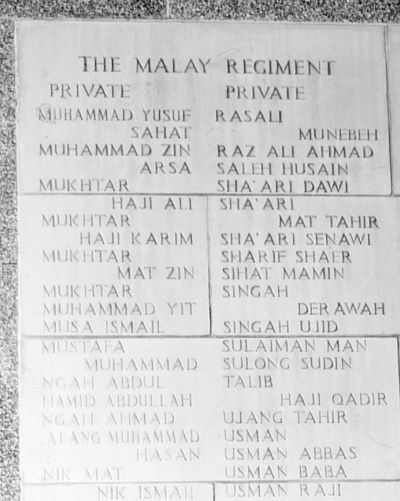
Singapore Memorial
On the 22nd February they made their way to the River Pandan estuary where they had arranged to wait for any other escapers. Here they could see the masts of two Chinese schooners which had been beached to block the estuary. On the following day, when they had given up hope of being joined by others, they went upstream where they found a 12 foot “bedar” [traditional Malay sailing boat], which they took down to the estuary to board the Chinese schooners. In these they found tins of water, ropes and a pole, from which it was possible to fit out and rig the “bedar”.
At about midnight, after the “bedar” had nearly sunk through its gunwale having become stuck under one of the schooners, they set sail and next morning they reached one of the Northern Merlimau islands where they found the villagers scared, but not unfriendly. The Japanese had previously ransacked the place, and as they were due back that morning, the villagers were anxious for the party to leave.
They thereupon headed for the Rhio islands where they hoped to be picked up by someone friendly. Whilst idling across the main Singapore Straight they passed within 400 feet of a Japanese destroyer and later very close to six Japanese mine-sweepers, but they were not stopped, presumably because of the Malay hats and coats which they were wearing.
At midday on 26th February they reached Tanjong Bali on Karimoen Island, where they received assistance from the Dutch and from where they were ultimately able to reach India.
Both Major Richards and Captain Bretherton were awarded the Military Cross.
At about midnight, after the “bedar” had nearly sunk through its gunwale having become stuck under one of the schooners, they set sail and next morning they reached one of the Northern Merlimau islands where they found the villagers scared, but not unfriendly. The Japanese had previously ransacked the place, and as they were due back that morning, the villagers were anxious for the party to leave.
They thereupon headed for the Rhio islands where they hoped to be picked up by someone friendly. Whilst idling across the main Singapore Straight they passed within 400 feet of a Japanese destroyer and later very close to six Japanese mine-sweepers, but they were not stopped, presumably because of the Malay hats and coats which they were wearing.
At midday on 26th February they reached Tanjong Bali on Karimoen Island, where they received assistance from the Dutch and from where they were ultimately able to reach India.
Both Major Richards and Captain Bretherton were awarded the Military Cross.
The price that was paid in blood by The Malay Regiment at Singapore
The Commonwealth War Graves Commission commemorates a total of 264 men of the Malay Regiment who died of all causes during World War II. These dead are listed on the Singapore Memorial, the Singapore (Unmaintainable Graves) Memorial, the Singapore Civil Hospital Grave Memorial, and on individual grave markers in Kranji War Cemetery, Singapore.
Because of the breakdown of regimental record keeping due to the British surrender in Singapore it is not possible to be accurate about how many men were killed or died of wounds in the final days of fighting. Dol Ramli’s excellent article comments that during the fighting on 12th, 13th and 14th of February The Malay Regiment lost 6 British officers, 7 Malay officers and 146 other ranks killed in action. A large but unspecified number of men were wounded and a number of them appear to have died from their wounds in the aftermath of the British surrender
Reflections at Bukit Chandu
Visitors to Singapore are strongly recommended to see the military museum titled Reflections at Bukit Chandu which is up on the ridge above Pasir Panjang Village. This is an absorbing World War II interpretive centre commemorating the stand of the Malay Regiment on the actual ground where the museum is located. Nearby on a coastal hill are the interesting remains of the Labrador gun battery and on Sentosa Island is another military museum based around the battery of guns that were located there.
Army Museum Port Dickson, Malaysia
Similarly visitors to the Kuala Lumpur area of Malaysia should see the Army Museum at Port Dickson, a pleasant coastal resort. The Museum can easily absorb two or three hours of your time and The Malay Regiment is strongly featured in the exhibits.
After World War II ended The Malay Regiment was reformed and survivors of the wartime unit were invited to return to its ranks.
“1st Malay was an experiment that now vindicated its champions.”
Brian Farrell in The Defence and Fall of Singapore 1940-42.
APPENDIX 1
Awards to The Malay Regiment for service in World War II
a. Distinguished Service Order:
Major James Richard Glencoe ANDRE (17888), The Lincolnshire Regiment (Chichester).
Major George Tancred DENARO, The York & Lancaster Regiment.
b. Military Cross:
Lieutenant Alister George MACKENZIE (225856), General List (Northampton). (Attached The Malay Regiment).
Lieutenant IBRAHIM BIN ALI DITTA, The Malay Regiment.
Captain (acting Major) Griffith Powell RICHARDS, (41421), The South Staffordshire Regiment (attached the Malay Regiment).
Second-Lieutenant (acting Captain) Edward Howard Stanley BRETHERTON (26935), General List (attached The Malay Regiment).
c. Military Medal:
No. 182 Private YACOB BIN BIN BIDIN, The Malay Regiment.
d. Member of The Order of The British Empire (MBE):
No. 88 Regimental Sergeant-Major ISMAIL BIN BABA, The Malay Regiment.
e. Mention in Despatches:
Lieutenant Colonel J.T. BRETHERTON-HAWKSHEAD-TALBOT MC (8257).
Lieutenant ABBAS BIN MOHD SAIID (since died).
Lieutenant ADNAN (90) (since died).
2nd Lieutenant ABBAS BIN ABDUL MANAN (283).
2nd Lieutenant NOOR DIN (315) (since died).
63 Sergeant ALI HASHIM BIN HASHIM.
246 Corporal ABDUL RANI BIN MAY HUSSEIN.
Private ABDUL WAHUB.
Endnote
The Military Medal awarded to No. 12766 Private BAN TSAN CHUAN In Supplement to The London Gazette No. 37671 appears to be wrongly attributed to The Malay Regiment as Private BAN’s unit as written on his citation was 3rd Malayan Volunteers Field Ambulance; also his Regimental Number does not fit in with Malay Regiment numbers. The citation is copied here for general interest:
This man was attached to 1 Argyll & Sutherland Highlanders with his ambulance during the fighting in Malaya from 14th December 1941 until 8th January 1942, when the unit was cut off at SLIM RIVER.
He showed marked gallantry, initiative and energy in transporting back wounded; in particular at GOPENG-DIPANG when Jap tanks had appeared and shot up some of the Argyll’s armoured cars, and the situation was much confused with heavy fighting in progress, he repeatedly drove his ambulance close up to the front, then some 200 yards away, to collect wounded.
SOURCES:
Ø K.D. Bhargava MA & K.N.V. Sastri PhD. Official History of the Indian Armed Forces in the Second World War 1939-45. Campaigns in South-East Asia 1941-42. (Pentagon Press reprint, Delhi 2012).
Ø Captain C.G.T. Dean MBE. The Loyal Regiment (North Lancashire) 1919-1953. (Regimental HQ The Loyal Regiment, Preston 1955).
Ø Brian P. Farrell. The Defence and Fall of Singapore 1940-1942. (Tempus paperback edition 2006).
Ø Major General S. Woodburn Kirby. UK Official History. The War Against Japan. Volume 1: The Loss of Singapore. (Naval & Military Press softback reprint).
Ø Jeff Partridge. The Alexandra Massacre. https://web.archive.org/web/20051018131718/http://www.nesa.org.uk/html/alexandra_massacre.htm
Ø Dol Ramli. History of The Malay Regiment 1933-1942. (Article in the Journal of the Malaysian Branch of the Royal Asiatic Society, Vol.38, Pt.1, (No. 207). Available on the internet on JSTOR.
Ø London Gazette Supplements No. 35670 dated Tuesday 18th August 1942, No. 37386 dated 13th December 1945, and No. 37671 dated Thursday 1st August 1946.
Ø The author’s own photographs.
|

